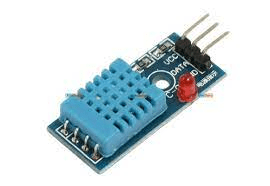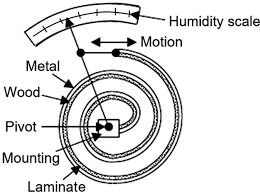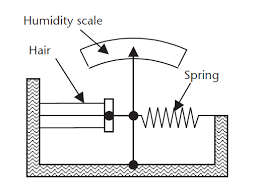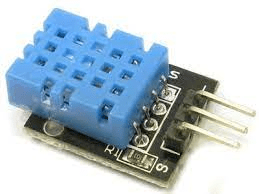The humidity sensor is also known as a hygrometer, that is used to measure humidity present in the air. Generally, both the humidity sensor & temperature sensor are used to detect humidity. Humidity is defined as the amount of moisture or water content present in the air. This water is present in gaseous form in the air. A less humid air indicates that the air is dry, which generally happens for dry areas. And high humidity means a lot of water is present in the air, which is the general case in coastal areas.
Temperature and humidity are closely related. If temperature and humidity both are high, we feel uncomfortable. Humidity sensors are used to measure this water content and classify the nature of the air. Humidity sensors are important, as the amount of humidity affects the performance of electronic equipment, and even proper care is taken while designing those, keeping humidity in view.
What is a Humidity Sensor?
Sensors, are the basic devices, to sense any quantity. Arduino sensors are the common electronic devices, used to measure quantity. Different types of Arduino sensors are shown below.
Humidity sensors are the devices that are used to measure the humidity present in the air. Humidity is defined as the amount of water content in the air. Humidity and moisture are different. Humidity refers to space, whereas, the term moisture refers to the water content present in the solids for liquids. Humidity sensors again give the output based on the classification of humidity. Hygrometers are one classical version of humidity sensors, which are used to measure humidity.

Humidity Sensor
Terms Related to Humidity
There are fundamentally three types of humidity. The first one is absolute humidity, which is defined as the fraction of mass of water vapor upon the volume of the air. Absolute humidity is given as (AH=m/v). In the expression for absolute humidity, the temperature does not occur, but absolute humidity depends on both temperature and pressure.
The second one is relative humidity. It is defined as the fraction of actual water vapor in terms of pressure, which is present in the air upon the water vapor pressure at maximum temperature present in the air. For the humidity sensors, relative humidity is more important as it indicates the probability of fog formation or probability of precipitation. Hence this forms as one of the important metrics.
The next classification of humidity is specific humidity. It is defined as the fraction of masses of both water vapor and air. Similarly, we have humidity ratio, which is defined as the fraction of masses of both water vapor and air, but at dry temperature.
The dew point temperature is defined as the temperature at which the humidity gets saturated in the air. The dew point is important to calculate the humidity. For example, we can say that the relative humidity at the dew point is 100%. So, a significant dew point specifies at what temperature, the air can hold the maximum amount of water vapor.
Types of Humidity Sensor
The humidity sensors are broadly classified as classical humidity sensors and modern humidity sensors. They are classified fundamentally based on the operating principles and configuration. The classical humidity sensors are further classified as metal paper foil type, hair tension-type, psychrometer, and chilled mirror dew point type humidity sensors. In literature, one would find the same name as hygrometers also. The classical humidity sensors are simple and evasive to implement. They work on simple physical fundamentals.
One more classification of humidity sensors is modern humidity sensors. They use advanced technologies in order to measure the humidity. Different types of modern humidity sensors are capacitive type, resistive type, thermal type, gravimetric and optical type. The classification of sensors can be shown as
Working of the Humidity Sensors
The working principle of two basic classical-based sensors is explained as follows. The first one is a metal paper foil-type humidity sensor, and the second one is a hair tension humidity sensor.
Metal Paper Foil
A metal paper foil-type humidity sensor is generally used to measure relative humidity at a certain place. It consists of a humidity scale to measure the humidity, metal foil, wood arrangement for placing the foil, a pivot to hold the pointer, a mounting arrangement to place the pivot and pointer, and laminate to prevent the foil from corrosion and others.

Metal Paper Foil Type
The pointer used to measure the humidity is attached to the foil. The working principle behind metal paper foil type humidity sensors is based on the deviation of the pointer and reading obtained on the scale. When the sensor is placed in the air, or at the place where the humidity is measured, then the paper strip attached to the wood absorbs the water vapor content from the atmosphere.
To further improve the absorption, a small amount of salt is also placed on the strip, so that it can easily absorb the vapor. Once the strip absorbs the vapor, its shape changes, making the dial move. Hence the deflection of the pointer is proportional to the change in the shape of the coil and hence the humidity. In this manner, the humidity is calculated from the atmosphere. Now we will see, the working principle of the hair tension humidity sensor. Its advantages are it is simple and inexpensive; however, its accuracy is limited.
Hair Tension Humidity Sensor
The hair tension humidity sensor consists of a hair, animal hair, or human hair, then a humidity scale, spring, a pointer to display the humidity level, and finally an arrangement to place the equipment. The hair is placed parallel to the beam, and the tension that the hair undergoes is measured as humidity.

Hair Tension Type
One important point to be noted is that the hair must be hygroscopic. That is the hair must have the tendency to absorb the water content from the atmosphere. It could be noted that the same feature is played by salt in the case of metal foil type. The working principle is, due to the hygroscopic nature of the hair, it absorbs the water vapor from the atmosphere, due to which, its size changes.
The increase in the dimension is reflected by the pointer scale arrangement. The amount of humidity the hair absorbs is proportional to the pointer deflection, and hence the humidity can be measured. This method is also evasive and inexpensive; however, it has better accuracy than the metal foil type.
Arduino Humidity Sensor
Based on the modern capacitive methods to measure humidity, Arduino-based humidity sensors are designed. These are highly IoT-based, accurate, as compared to classical method-based humidity sensors.

Humidity Sensor Arduino
It has a digital output, pin configured methodology to measure humidity. It uses thermistors to sense the humidity around. The best part of this device is measured, humidity can be transmitted through computers and further used for different applications.
Structure and Specifications
DHT11 is a well-known, Arduino sensor with four pins. The first one is VCC to connect to supply, then data pin for transmitting the data, then NC and ground. The VCC pin requires a voltage of around 3-5 V. The maximum current rating is up to 2.5mA, with 100% humidity, and can work in the temperature range of -40 to 80 degrees centigrade. It can be connected through breadboard, and resistive components.
Please refer to this link to know more about Humidity Sensor MCQs
Humidity Sensor Applications
Different applications of humidity sensors can be enlisted as
- Home heating
- Ventilating
- Air conditioning
- Industrial places
- Fire Safety
- Weather reports
- Laboratory
- Engineering projects
1). What is the use of humidity?
Ans. Humidity represents the water content in the air. Based on humidity, building designs, and other information can be collected
2). What is a humidity sensor in IoT?
Ans. Humidity sensor in IoT is Arduino based sensor, designed to measure humidity
3). Where do we use humidity sensors?
Ans. Humidity sensors are used to measure humidity for applications such as air conditioning, ventilating, and so on.
4). How reliable are humidity sensors?
Ans. Humidity sensors designed with modern technology like capacitive methods are very reliable, as compared to classical-based sensors.
Hence, we have seen the working principle and classification of a humidity sensor or hygrometer. Due to the advent of IoT devices, these have found huge applications in recent times. Here is a question for you, what are the disadvantages of a humidity sensor?